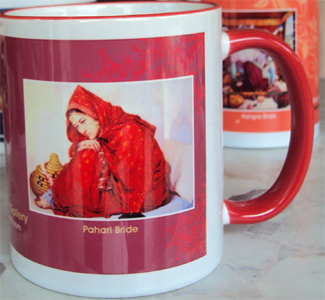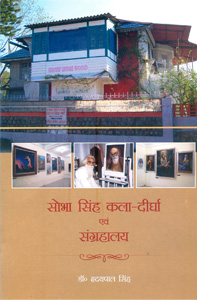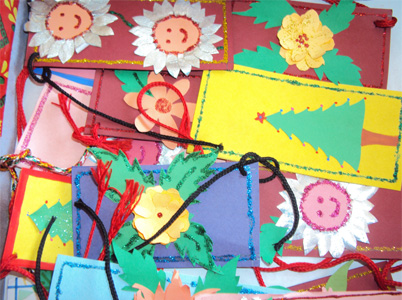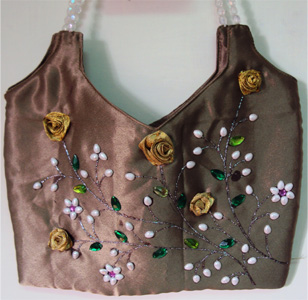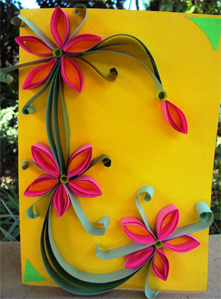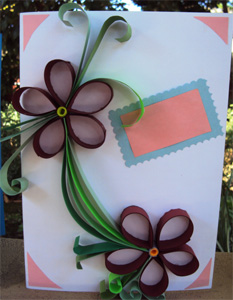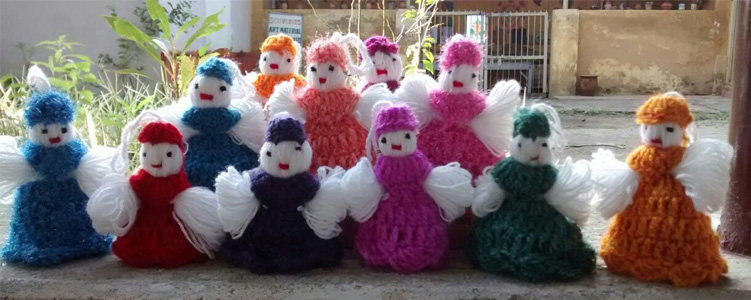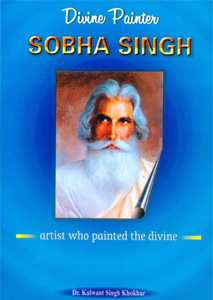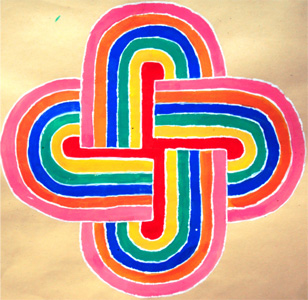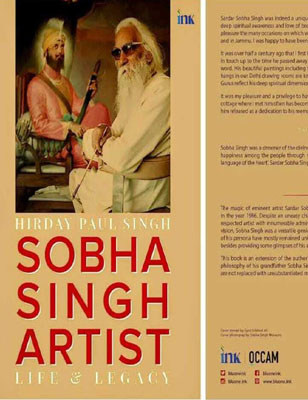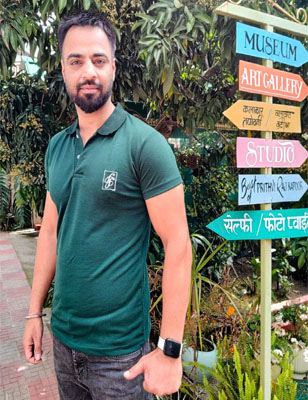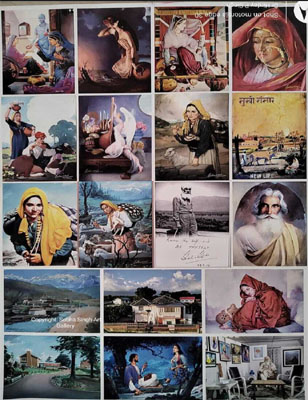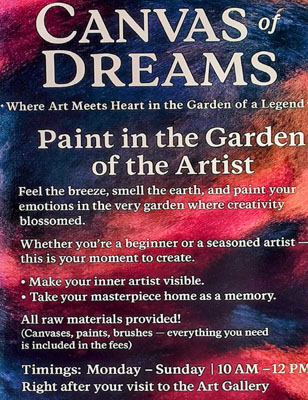Main Life Events
Birth: 29 November, 1901 at Sri Hargobindpur, Distt.Gurdaspur, Punjab, India. He was the fourth and the youngest child in the family
Parents and forefathers: Father S.Deva Singh: Surveyor in the Indian Army (Battalion 22).A trained cavalier and a talented painter. Served the army for 22 years, remained pensioner for 25 years and died at the age of 67 in the year 1917. Mother Bibi Achhran Devi: A delicate, charming and soft spoken lady. Died in 1906 after a prolonged illness. Grandfather S.Charhat Singh: A respected Cavalier in the Army of Maharaja Ranjit Singh. Sister Bibi Lachhmi Devi was 12 years elder to the artist. She was married to S.Mangal Singh, an overseer in M.E.S. at Amritsar. The child Sobha Singh was deeply attached to his sister from whom he got motherly affection and care due to premature death of his mother. His elder brother Mangat Singh died in infancy and another sister Kishan Kaur was married to S.Khazan Singh of Amritsar.
Experience: Learnt drawing from his brother-in-law and attended one-year course in Art & Craft from Industrial School, Amritsar (1915). Served Amritsar cantonment for a brief period before proceeding to Baghdad (Iraq) as Head Draughtsman in Indian Army (1919-1923). He learnt English and was fascinated by the painting skills of army officers, who also provided him books on art. Honed his skills of painting during his stint in army.
Other Important Events
1923: Married to Bibi Inder Kaur (daughter of S.Ram Singh, a moneylender-cum-typist of village Harchowal, Gurdaspur) on Baisakhi day, left
army & opened Subhash Studio at Phawara Chowk, Amritsar.Was influenced by freedom fighters including Netajee Subhash Chander Bose.
1925-1929: Established Echo School of Art at Anarkali, Lahore. Got reputation as a successful commercial artist. Came in contact with Dr.M.S.Randhawa(later ICS) and Giani Kartar Singh Hitkari(father of Amrita Pritam).Also painted many titles/sketches for magazines. Titles of two such magazines, “Chand”, 1928 and “Karak” were also painted by him. These magazines were banned by the Govt. as these were produced by freedom fighters.
1930-1942: Studio at Connaught Circus, Delhi. Painted posters, paintings, etc. for Indian Railways, Post & Telegraph Deptt. and Maharajas of Princely States. Participated in exhibitions (including Annual Exhibitions by Simla Art Society) & won many medals/prizes. Established himself as a prominent artist. In 1935, two his paintings were included in London Illustrated Weekly. Painted famous, “Nam Khumari Nanaka..” painting in 1937. “Noor Jahan in the Durbar of Guru Hargobind”, another painting was published in “Civil and Military Gazette of Lahore”, which caused lot of excitement among some people. Some reprints of his paintings were reproduced. Many of his works were acquired by officers and others from the Govt. Two such works were auctioned in 2004 in London.
He wanted to settle in Kangra valley during this period but did not get good piece of land.
1942-1944: Stayed at Pritnagar. Imparted training to the students of fine arts. Met many writers, playwrights, etc. Visited Andretta with an aim to settle down but other professional obligations kept him busy in city life.
1945: Served as Chief Artist in Publicity Deptt. of Indian Army. Painted posters for the historical Shimla Conference.
1946: Art Director of “But Tarash” movie at Lahore. Met Prithvi Raj Kapoor, later a bosom friend. His bust was made twice by the artist; one still adorns his Grow More Good House, Andretta.
1947: Left Lahore on the eve of partition leaving behind around 300 Art-works, including sixty priceless paintings & other valuables. Some of the paintings were in the custody of his friend at Shekhupura and some were left in the custody of his another friend at Lahore. These could not be retrieved due to increased violence. Settled permanently at Andretta (Kangra valley).
1948: Dr.M.S.Randhawa, ICS, rehabilitation commissioner arranged exhibition of his works at Sirhind Club, Ambala.Some of the paintings were sold to Air Force. Painted posters for Govt.of India to collect funds for rehabilitation work. Constructed a mud walled thatched cottage after purchasing four Kanal land. Made extensive study of psychology, comparative religion, sociology and art and continued to delve deep into philosophy.
1953: Yuvraj Karan Singh acquired many paintings including famous Sohni Mehiwal. This was printed for the first time and it remains most sought after reprint even now.
1967: Wife passed away on 15 January.
1969: Famous painting of Guru Nanak Dev (hand raised in blessings) published by S.G.P.C. More than five lac copies were sold.
1970: Punjabi University bestowed life fellowship.
1972: Visited U.K. Nominated to several high level committees of the Punjab Govt.
1973: Union Ministry of Information & Broadcasting made a documentary film, “Painter of People” on him. It has been dubbed in all major Indian languages. A paralytic stroke put him in bed for six months. Governors of Punjab visited him (Dr.D.C.Pavte & Mr.M.M. Chaudhary) with the offer to shift to Punjab for better medical care, etc. Artist politely declined expressing his love for the hills and serene environs.
1974 : Govt.of Punjab acclaimed him as State Artist, made documentary and honoured him.
1975: Prime Minister of India & other dignitaries visited exhibition of his painting at AIFACS on his 75TH birthday.
1976: Govt.of Punjab offered a gift of Studio-cum-Residence at Chhatbir (Patiala). Artist refused to accept attached conditions.
1978: Visited Rome to see historical monuments, art galleries and make art collections.
1982: Punjab Art Council honoured him with its highest award.
1983: Govt. of India decorated him with ‘Padam Shree’ on Republic Day. It was followed by honours from many organizations in different parts of the country.
1984: BBC, London made a documentary on him. Visited Switzerland, Norway, Canada, UK, etc.
1985: Doctor of Literature (Honoris Causa) conferred by Punjabi University, Patiala.
1986: Passed away on 22 August at Chandigarh. Cremated with full Sate honours.
After him:
Around fifty of his classic works are on display at Sobha Singh Art Gallery, Andretta (Palampur).This gallery is managed by his daughter Bibi
Gurcharan Kaur, herself an accomplished artist. She is assisted by her son Dr.Hirday Paul Singh, daughter-in-law Mrs.Kamaljit Kaur and grand
children Master Navratan Singh and Baby Sargun Kaur.
Collection of works
Painted around 2000 art works. Most of the works are preserved in Museums, private collections in India and abroad. Some paintings are on display
at Rashtrapati Bhawan, Lok Sabha, Raj Bhawans, Govt. Museum & Art Gallery (Chandigarh), Amar Mahal Museum(Jammu), Slar Ganj Museum (Hyderabad),
Central Sikh Museum(Amritsar),Punjabi University(Patiala),etc.
Sobha Singh Art Gallery & Museum
Sobha Singh Art Gallery and Museum is a gem hidden in Himachal Pradesh’s Kangra Valley in the lap of spectacular Himalayan Mountains. S.Sobha
Singh Artist (1901-1986), settled at Andretta, near Palampur after the partition of the country. He designed his own house, studio and art gallery
with a sign, “Grow More Good”, which sums up his philosophy on art and life.
During his four decades of creativity, he painted a large number of paintings on the various themes which included Sikh Gurus and Prophets, National heroes and freedom fighter, love legends and portraits. During his life time, many commoners and connoisseurs used to visit him and interact with him on art, life and philosophy.
After his demise, the family members of the late artist renamed the gallery as Sobha Singh Art Gallery where around three dozen original art works of the artist are on display. These include Guru Gobind Singh, Lord Rama, Shaheed-e-Azam Bhagat Singh, Lal Bahadur Shastri, Maharaja Ranjit Singh, Sohni Mehiwal, Her Grace the Gaddan, etc.
In 2011, the family members vacated the residential area and converted it to Sobha Singh Museum. The museum displays life journey of S.Sobha Singh in around 150 photographs. Some of his personal belongings like brushes, paints, books, beds, chairs, sticks, radio-cum-record player, clothes, etc. and other memorabilia is preserved here. Many people are not aware that he was a good sculptor also and some of his works in Plaster of Paris (PoP) are also on display. The sculptor of his bosoms friend and theatre personality Prithvi Raj Kapoor adorns the facade of his studio. In the year 2015, two more sections in the Museum have been added which include a corner for Bibi Inder Kaur, wife of saint-artist where some photographs and personal belongings of the family are displayed. Another section is dedicated to the wood works like frames and designs crafted during the life time of the artist. His chair, couch, easel and some rare works have been displayed in this section.
Despite the offers of huge sums to purchase any of the painting of the late artist, the family has decided not to part with any work and is very clear that this is a national heritage which they will continue to look after and preserve for the coming generations. Efforts have been made to invite international experts to suggest conservation and preservation of the invaluable works.
The gallery and museum is managed by Bibi Gurcharan Kaur, the daughter of the late artist and she is ably assisted by her son Dr.Hirday Paul Singh and family. The gallery is sustaining on the limited resources of the family and is not dependent on any support from any quarter. Yet, it makes earnest effort to preserve the rich heritage of the area, State and Nation to propagate the philosophy “Grow More Good”. The gallery, from time to time, rekindles the creativity of bygone years, by organizing various art oriented activities on the occasion of birth anniversary of the artist. Recently, during Sobha Singh Kala Utsav( 17-22 November, 2014), around fifty rural ladies were trained in the dying folk art ‘Likhnu’ and art-craft work. Around two hundred school students were imparted training in Greeting Cards making besides art quiz and on the spot competitions were also organised for them. Some expert lectures on the art and culture of the State were also organized.
Many visitors from India and aboard travel to the galley and museum. They are keen to see the masterpieces and feel the sanctity and romance of the place where S.Sobha Singh spent four decades of creativity.
Prampara, the Souvenir Shop
A souvenir shop has been opened for the original prints of major works by the artist. Now, prints are also made available on archival paper and
canvas. Literature on S Sobha Singh is also available besides printed mugs with some of the classic works. DVDs of his life and work and view cards
have been added in the souvenir shop and the artists can also purchase art material like paints, brushes, easel, canvas boards, etc.
An effort has been made to preserve the local folk art and craft. The locally made handicrafts are recent addition in Prampara.

